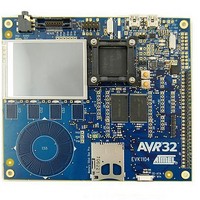ATEVK1104S Atmel, ATEVK1104S Datasheet - Page 7

ATEVK1104S
Manufacturer Part Number
ATEVK1104S
Description
KIT EVAL FOR AT32UC
Manufacturer
Atmel
Series
AVR®32 UC3r
Type
MCUr
Specifications of ATEVK1104S
Contents
Board, Cables
Tool Type
Development Kit
Cpu Core
AVR 32
Data Bus Width
32 bit
Processor Series
AT32
Processor To Be Evaluated
AT32UC3A3256S
Interface Type
USB, JTAG, SD Card, Nexus, MMC
Core Architecture
AVR
Operating Supply Voltage
5.5 V
For Use With/related Products
*
Lead Free Status / RoHS Status
Lead free / RoHS Compliant
3.6 Fast Fourier Transform
32138A-AVR32-02/10
In this application, we will apply the two basic filters, a high-pass and a low pass filter.
Applying the filters:
•
•
•
•
•
We will now have a closer look at the filters effect on the signal. By adjusting the
frequency of the input signals the filters will let more or less of the signal pass
through.
With an increase of frequency of a given signal, a low-pass filter will let less of it pass
through. By increasing the frequency of signal 2, it will be even less visible in the
output signal.
Higher frequency:
•
•
•
Lower frequency:
•
•
At 1 kHz, the remains of signal 2 are clearly visible in the output signal. By comparing
this to the known behavior called the frequency response of the filter, we see how our
observations match with the theory. At 1 kHz, called the filter’s cutoff frequency, the
noise is only reduced by 3 dB, which is equal to 50%.
FUN FACT: If we reduce the frequency of source 2 to approximately 433 Hz, signal 1
and 2 will have almost the same frequency. This will generate a vibrating volume
sound effect as signal 2 changes rapidly between amplifying and damping the output
signal. Experimenting with the frame rate and frequency of signal 2 will generate a
very visible and audible demo of this effect. The frequency of the vibration will be
equal to the difference in frequency between the two signals. This is most audible
when the difference is 4 Hz.
Fast Fourier transform (FFT) will extract the frequency components from a signal. The
theory behind this function is very complicated, but it provides a strikingly simple
output that can be very useful when analyzing the behavior of a digital signal
processing system.
Push and hold the BACK button for 3 seconds to reset the signals and filters.
Select the filter box and select the high-pass filter by pushing FUNC2.
Observe how the low frequency component of the output signal is reduced,
making the output very similar to signal 2.
Select the low-pass filter by pushing FUNC3.
Observe how the high frequency component of the output signal is reduced,
making the output very similar to signal 1.
Select signal source 2
Change the frequency to 5 kHz or more
Observe how the high frequency signal is clearly visible in the combined signal,
but not in the output signal
Select signal source 2 again
Reduce the frequency to about 1 khz
AVR329088
7












